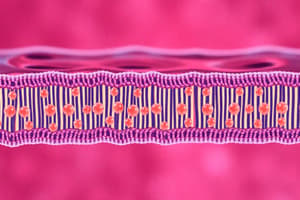Podcast
Questions and Answers
Which of the following is NOT a common drug target according to the text?
Which of the following is NOT a common drug target according to the text?
- Receptors
- Structural proteins (tubulin)
- Enzymes
- Nucleic acids (correct)
In the context of drug targeting, which type of bonds are mentioned as different from covalent bonds?
In the context of drug targeting, which type of bonds are mentioned as different from covalent bonds?
- Disulfide bonds (correct)
- Van der Waals forces
- Ionic bonds
- Hydrogen bonds
Where are proteins, the most common drug targets, mainly located according to the text?
Where are proteins, the most common drug targets, mainly located according to the text?
- Mitochondria
- Cell membrane or cytoplasm (correct)
- Endoplasmic reticulum
- Cell nucleus
What does a drug target do when a drug binds to it according to the text?
What does a drug target do when a drug binds to it according to the text?
What type of bonds are the strongest intermolecular bonding forces mentioned in the text?
What type of bonds are the strongest intermolecular bonding forces mentioned in the text?
Which type of bond involves directional orbitals and has an optimum direction where the X-H bond points directly to the lone pair on Y?
Which type of bond involves directional orbitals and has an optimum direction where the X-H bond points directly to the lone pair on Y?
Which is an example of a good hydrogen bond donor according to the text?
Which is an example of a good hydrogen bond donor according to the text?
What type of drug-target interaction involves transient areas of high and low electron densities causing temporary dipoles?
What type of drug-target interaction involves transient areas of high and low electron densities causing temporary dipoles?
In what type of environment are ionic interactions stronger, according to the text?
In what type of environment are ionic interactions stronger, according to the text?
Which of the following is NOT an example of a good hydrogen bond acceptor based on the text?
Which of the following is NOT an example of a good hydrogen bond acceptor based on the text?
What happens to the strength of dipole-dipole interactions as the distance between molecules increases?
What happens to the strength of dipole-dipole interactions as the distance between molecules increases?
How do ion-dipole interactions compare to dipole-dipole interactions in terms of strength?
How do ion-dipole interactions compare to dipole-dipole interactions in terms of strength?
What is the primary characteristic of induced dipole interactions?
What is the primary characteristic of induced dipole interactions?
Which intermolecular force involves the interaction between aromatic rings?
Which intermolecular force involves the interaction between aromatic rings?
In what scenario would dipole-dipole interactions be detrimental to molecular orientation in a binding site?
In what scenario would dipole-dipole interactions be detrimental to molecular orientation in a binding site?
What is a distinguishing feature of Pi-stacking (π-π stacking) compared to other types of intermolecular forces?
What is a distinguishing feature of Pi-stacking (π-π stacking) compared to other types of intermolecular forces?
What type of interactions are involved in Pi-stacking (π-π stacking)?
What type of interactions are involved in Pi-stacking (π-π stacking)?
What is necessary for desolvation to occur during drug-target interactions?
What is necessary for desolvation to occur during drug-target interactions?
What contributes to the increase in entropy during drug-target interactions involving hydrophobic regions?
What contributes to the increase in entropy during drug-target interactions involving hydrophobic regions?
What type of bonds are most commonly formed between a drug and its target according to the text?
What type of bonds are most commonly formed between a drug and its target according to the text?
Which type of bond involves an optimum direction where one bond points directly to the lone pair on another?
Which type of bond involves an optimum direction where one bond points directly to the lone pair on another?
What do hydrophobic interactions in drug targeting specifically 'free up', leading to higher entropy?
What do hydrophobic interactions in drug targeting specifically 'free up', leading to higher entropy?
Flashcards are hidden until you start studying




